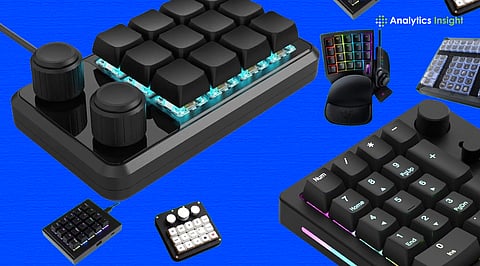

Overview:
Programmable macropads give you dedicated keys or knobs that you can map to complex commands, shortcuts, or macros - saving time in both work and play.
These devices vary in size and functionality: some offer only a few keys for simplicity, while others include multiple keys and rotary encoders (knobs) for greater control.
Many of these macropads are compatible with customizable firmware or onboard memory, letting you switch between macro profiles depending on your task (e.g., streaming, gaming, editing).
Everything is constantly in motion in a fast-paced digital world, and every second matters - whether you're creating content, playing games, or handling repetitive tasks. A programmable macropad is a powerful tool for setting up, managing, and executing commands, shortcuts, and macros within a single compact device. It offers an efficient alternative to a traditional keyboard or mouse by allowing users to switch to a smaller, specialized device for executing complex processes.
Here are the 10 top programmable macropads / macro keypads:
This 12-key macro keypad is one-handed and lets you create complex shortcuts. Programming is available for each key, and the device has a solid mechanical structure.
The big macro pad offers 16 programmable keys and 3 encoders, allowing one to customize functions for controlling media, software shortcuts, or even macro profiles with layers.
Also read: Best Monitors for Dual Monitor Setup in 2025: Boost Productivity and Gaming Experience.
This 8-key macro controller is compact, RGB-backlit, and supports macro programming. It is perfect for gaming, productivity, or stream control, offering a good balance of size and functionality.
Incorporating six mechanical keys and a rotary encoder, this macropad offers both a button and a dial. The dial can be used to zoom, adjust volume, or navigate between layers.
This one-handed macro pad has nine programmable keys and supports macro layers. It is small but powerful, thus suitable for both workflows and shortcuts.
The keypad comes with RGB lighting on every key, for a total of 12 programmable mechanical keys, plus a control adjustment knob.
Serious users requiring complete macro control, this device, with 16 programmable keys, three knobs, and onboard memory, offers decision-making power.
Looking like a mini-MIDI controller, the Midi-Style 12-Key Macro Pad with 2 Knobs features two knobs and lets you assign both macro commands and continuous controls.
The OSU game layout inspires the appearance of this extremely compact 3-key pad. Each key can be customized for macros, which is why it is very useful for tasks that need to be done repeatedly, for fast shortcuts, or for launching key commands.
Also read: Best GPUs for Ryzen 9 7900X & 7950X in 2025: Great Picks for Gaming & Productivity.
These 10 programmable macropads are incredibly useful for a wide range of users, including content creators, gamers, or anyone who dislikes repetitive desktop shortcuts. You can choose from small 3-key pads to advanced multi-knob 16-key macro controllers, depending on your workflow needs. The 16-key NLOFIN model offers the highest level of customization. Conversely, if portability and simplicity are your main priorities, the 3-key GOWENIC or OSU-style pad would be an excellent choice.
1. Do I need special software to use macro pads?
Not necessary; many macro keypads are simply connected and also provide built-in memory for key-mapping customization.
2. Can I use a MacroPad on both Windows and Mac?
Indeed, most macro pads use a USB connection and work with both Windows and macOS.
3. Are rotary knobs useful on a macro pad?
For sure, volume, zoom, scrolling, and switching between macro layers could be controlled with knobs (rotary encoders).
4. Will a 12-key pad be enough for complex workflows?
The answer depends on a specific case. If the requirement is only a few shortcuts or macros, then the 12 keys may be enough.
5. Do all macro pads support multiple layers?
Not every one of them, but a majority do. High-end macro pads with more advanced firmware or memory usually allow the creation of multiple layers or profiles for various use cases.
